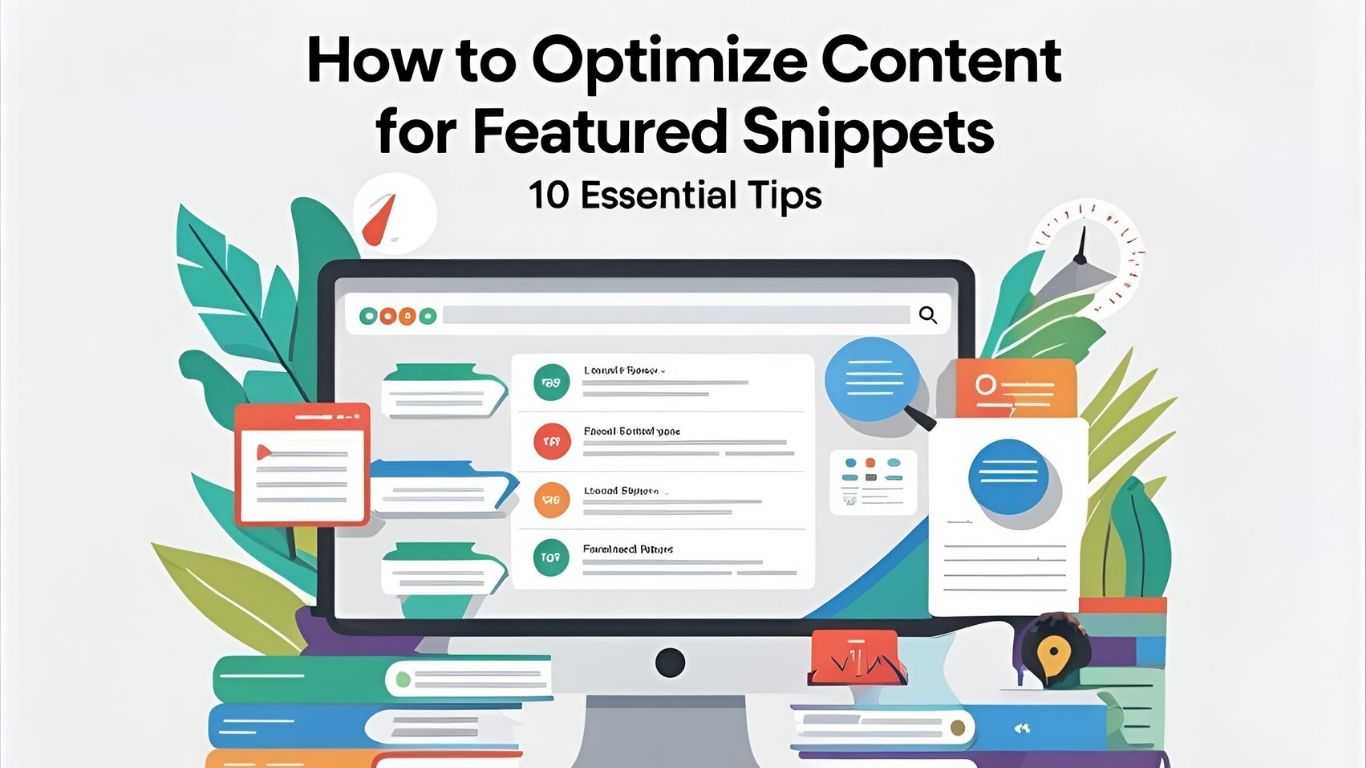10 Proven Strategies to Optimize Content for Featured Snippets #SEO #ContentOptimization #FeaturedSnippets
How to Optimize Content for Featured Snippets: 10 Essential Tips
Introduction
Are you wondering how to optimize content for featured snippets and grab that coveted top spot on Google? Let me tell you, it’s not as difficult as it sounds. Picture yourself at the top of the search engine results page (SERP), your content displayed in a neat box, answering the question that millions of users are searching for. That’s the power of featured snippets!But how do you get there? It’s all about content formatting, targeting the right keywords, and giving Google what it craves—structured, easy-to-digest information. In this guide, I’ll take you through a step-by-step process of optimizing content for featured snippets, using practical tips, relatable examples, and a little bit of wisdom.
Why Featured Snippets Matter
The Digital Stage and Your Spotlight
Imagine standing on a stage, spotlight on you, and everyone in the audience is watching. That’s what ranking in a featured snippet feels like. You get the highest visibility possible, and that makes all the difference.
Featured snippets are the boxed answers that appear at the top of Google search results. Unlike regular search results, featured snippets show up in position zero. This gives your content a huge advantage over others, increasing both your visibility and credibility.
They Drive Traffic
Let’s talk numbers. Studies show that over 30% of all clicks come from featured snippets, which means you get access to a wider audience. Higher click-through rates mean more traffic, which translates to increased leads, sales, or whatever your goal may be.
But it’s not just about the clicks. People trust featured snippets. When Google picks your content as a featured snippet, it’s like a stamp of approval. It tells users that your content is authoritative, reliable, and directly answers their question.
How to Identify Featured Snippet Opportunities
Keywords: Your Golden Ticket
The first step in optimizing content for featured snippets is identifying the right keywords. Keywords are the bridge that connects your content to users searching for answers.
Start by looking for “question-based keywords” like “How,” “What,” or “Why.” These are prime candidates for featured snippets. For example, search for “how to make pizza dough” or “what is SEO.” These keywords tend to pull up featured snippets because they promise a direct answer to a user’s question.
Tools to Help You Find Featured Snippets
Finding these opportunities is easier with tools like SEMrush, Ahrefs, or Google’s Keyword Planner. These tools can help you uncover search queries that trigger featured snippets. For example, if you type in a question like “how to bake chocolate cake,” Google will show the most commonly used snippets, helping you understand the best way to structure your own content.
Types of Featured Snippets
Paragraph Snippets: The Most Common Type
A paragraph snippet is a simple, concise answer to a question. This type of snippet is the most common and shows up as a short paragraph right at the top of the search results. When optimizing for paragraph snippets, focus on answering the question directly in a single paragraph of around 40-50 words.
List Snippets: A Structured Approach
List snippets are a great way to present information in an organized, step-by-step format. These work well when you’re explaining processes, how-tos, or even pros and cons. For example, “Top 5 Ways to Stay Healthy” can be formatted as a list snippet.
Table Snippets: Data at a Glance
A table snippet is ideal for presenting data in a neat, structured format. If your content involves comparisons, statistics, or step-by-step processes with numbers, this is your go-to option. Formatting your content into easy-to-read tables can help you capture that coveted snippet spot.
Formatting Your Content for Snippets
Concise and Structured Content
The way you structure your content can make or break your chances of getting featured. Google loves content that’s easy to understand, and that’s exactly what you need to provide. Use clear, short sentences that get straight to the point.
Bullet Points and Numbered Lists
Incorporating bullet points or numbered lists is one of the best ways to optimize content for featured snippets. Google loves well-structured lists because they provide quick, digestible information.
Answering Questions Directly
Google’s goal is to provide users with the most relevant answer in the shortest amount of time. So, if you’re aiming for a featured snippet, make sure you directly answer the query in your content. No fluff, no filler—just clear, concise answers.
Answering User Intent
Understanding Search Intent
One of the keys to optimizing content for featured snippets is understanding user intent. Why is someone searching for “how to bake a cake” or “what is SEO”? Understanding their motivations helps you craft content that satisfies their needs.
Align Your Content with Intent
Once you understand what users are looking for, it’s time to align your content accordingly. If users want a step-by-step guide, offer them a detailed process. If they’re looking for a quick answer, keep your content short and to the point.
Optimizing Content for SEO
Keyword Targeting for Featured Snippets
When optimizing content for featured snippets, targeting the right keywords is crucial. Focus on long-tail keywords that are question-based or provide specific solutions. Include these keywords naturally within your content, making sure they appear in headers, subheadings, and throughout the text.
Schema Markup: A Hidden Gem
Schema markup is a type of code that you can add to your website’s content to help search engines understand it better. It’s like a roadmap for Google, guiding it to the most important parts of your content. Using schema markup can increase your chances of being selected for a featured snippet.
On-Page SEO Techniques for Snippet Success
On-page SEO techniques, such as optimizing meta tags, alt text for images, and internal linking, can help boost your chances of ranking in a featured snippet. These simple yet effective strategies ensure that Google recognizes your content as relevant and authoritative.
Creating Content with High Engagement
Crafting Engaging Titles
A compelling title is your first opportunity to hook readers. Make sure your title is both SEO-optimized and intriguing. You can even use your target keywords in the title to boost relevance.
Using Visual Elements
Visual elements like images, charts, and infographics not only make your content more engaging but can also help you rank for image-based snippets. Google loves rich media, so don’t overlook this when optimizing for featured snippets.
Writing for Reader Retention
Great content isn’t just about rankings—it’s about keeping your readers engaged. Use relatable analogies, ask questions, and engage with your audience emotionally. This helps build trust and makes readers more likely to return to your site.
Structuring Content for Snippets
Use Headers and Subheaders
Headers and subheaders break your content into digestible chunks, making it easier for both readers and Google to navigate. Use them strategically to highlight key points, and include your target keywords where appropriate.
Best Practices for Length and Clarity
The ideal length for content optimized for featured snippets is between 100-200 words per section. This allows you to provide enough information without overwhelming the reader. Keep sentences short and clear for easy readability.
Technical SEO for Featured Snippets
Page Speed Optimization
Page speed is critical when it comes to both SEO and featured snippets. If your page takes too long to load, users will bounce before they even get a chance to see your content. Optimize images, use caching, and minimize unnecessary scripts to ensure your page loads quickly.
Mobile Optimization
With mobile traffic on the rise, optimizing your content for mobile devices is essential. Google prioritizes mobile-friendly pages, so make sure your site is responsive and easy to navigate on smartphones and tablets.
Advanced Tips for Featured Snippets
Using Data and Statistics
Statistics and data are highly effective in securing featured snippets, especially for list and table snippets. If you can back up your points with solid data, Google will see your content as more authoritative.
Crafting Highly Specific Answers
When answering a question, be as specific as possible. If you can provide a direct, detailed answer that clearly addresses the query, you’ll have a higher chance of being featured.
The Role of Content Authority
Building Credibility
Google prefers content that comes from authoritative sources. The more credible your content is, the higher your chances of ranking for featured snippets. Building backlinks from reputable sites can help establish your authority.
Leverage Backlinks for Snippet Visibility
Backlinks are a powerful SEO tool. The more high-quality backlinks you have, the more likely Google is to view your content as trustworthy and authoritative, increasing your chances of earning a featured snippet.
Common Mistakes to Avoid
Overcomplicating Content
One common mistake is overcomplicating the content. Featured snippets thrive on simplicity. Keep your answers clear and concise—no need for lengthy explanations or overly complex language.
Ignoring User Engagement
Google values engagement. If users are bouncing from your content, it signals that your answer isn’t meeting their needs. Ensure that your content is engaging, easy to read, and provides real value to your audience.
Measuring Success with Featured Snippets
Monitoring Rankings and Visibility
Track your rankings for featured snippets using tools like Google Search Console or Ahrefs. Keep an eye on how your content is performing and make adjustments as needed.
Tools to Track Featured Snippet Performance
There are various tools available to track your featured snippet performance. Use them to monitor changes in your rankings and identify areas where you can improve your optimization efforts.
Conclusion
Optimizing content for featured snippets is one of the best ways to boost your SEO and increase your visibility. By targeting the right keywords, formatting your content properly, and engaging with your audience, you can improve your chances of ranking in this coveted spot. Remember, the journey doesn’t end with a snippet—it’s about providing value, building authority, and continuing to refine your content. So go ahead, optimize your content, and watch your site rise to the top of the search results!
Bullet-Point Summary:
- Featured Snippets give your content prime visibility at the top of search results.
- Target question-based keywords for the best chance of triggering a featured snippet.
- Featured snippets include paragraph snippets, list snippets, and table snippets.
- Formatting your content with clarity, bullet points, and numbered lists increases your chances.
- Focus on answering user intent directly and concisely for better snippet optimization.
- Schema markup helps Google better understand your content and increases snippet chances.
- Mobile optimization and page speed are essential for ranking in featured snippets.
- Craft engaging, data-driven content to improve your chances of earning snippets.
- Backlinks and content authority increase your snippet visibility.
- Avoid overcomplicating content and ensure it’s easy to read for higher engagement.
- Regularly track rankings and visibility using tools like Google Search Console.
- Adjust content based on performance data to keep improving your snippet ranking.
- Featured snippets drive more traffic and offer higher click-through rates.
- Always structure content with clear headings and subheadings for better readability.
- Monitor your snippet performance to continually optimize for the best results.
- Featured snippets are powerful tools for SEO success and boosting site credibility.
FAQs
What is a featured snippet in SEO?
A featured snippet is a boxed summary of an answer to a user’s query that appears at the top of Google’s search results. It’s designed to provide the most relevant and concise answer directly in the search engine results page (SERP).
Why do featured snippets matter for SEO?
Featured snippets drive more visibility and traffic to your website by placing your content at the top of search results, even above traditional search listings. This increases click-through rates and builds your site’s authority.
How can I optimize content for featured snippets?
Focus on clear, concise answers to common questions. Use structured formats like lists or tables, and target question-based keywords. Additionally, optimize your content with proper SEO techniques, including schema markup and mobile optimization.
What are the different types of featured snippets?
There are three main types: paragraph snippets, list snippets, and table snippets. Paragraph snippets are short answers, list snippets display steps or rankings, and table snippets showcase structured data.
How long should my answer be for a paragraph snippet?
Ideally, your answer should be between 40 to 50 words. It should be direct and concise, providing just enough information to answer the question clearly.
Do I need schema markup for featured snippets?
While schema markup isn’t a guarantee for featured snippets, it helps Google understand your content better, which can improve your chances of being featured. It’s a valuable SEO tactic for snippet optimization.
Can I get multiple featured snippets for one page?
Yes, it’s possible for one page to appear in multiple featured snippets, especially if it answers various types of questions. This can happen when you format your content well and target multiple relevant queries.
How do I track featured snippets on my website?
Tools like Google Search Console, Ahrefs, and SEMrush allow you to track your rankings for featured snippets. These tools help monitor the performance of your content in SERPs.
Does content length matter for featured snippets?
Yes, content length is important for featured snippets. Google prefers short, concise content that answers questions directly. However, for list and table snippets, longer content with structured data can work well.
What are common mistakes to avoid when optimizing for featured snippets?
Avoid overcomplicating your content. Google favors simplicity, so ensure your answers are direct, easy to read, and well-structured. Also, make sure your content is highly relevant to the search intent.
Can featured snippets help improve my website’s domain authority?
Yes, by appearing in a featured snippet, you gain more visibility, which can lead to more backlinks, social shares, and overall traffic, thus improving your website’s domain authority.
How do I find featured snippet opportunities?
Use keyword research tools to identify questions users are asking. Look for long-tail, question-based keywords and check if these result in featured snippets on Google.
Is mobile optimization important for featured snippets?
Absolutely. With the increasing use of mobile devices, Google prioritizes mobile-friendly pages. Ensure your content is easy to read on mobile to improve your chances of getting featured.
How do I structure content for a list snippet?
For a list snippet, break down your content into numbered steps or bullet points. Make sure each item in the list is clearly defined and directly answers the user’s query.
What’s the best way to format a table snippet?
When creating content that could appear in a table snippet, make sure to format your data clearly, using headers and rows that are easy to interpret. Include detailed yet concise information, such as comparisons or statistics.
Explore These Valuable Resources
To enhance your understanding of featured snippets and optimize your content effectively, here are some expert resources that can provide valuable insights. These links will guide you through the latest trends and best practices in SEO, content optimization, and more.
Google Search Central Blog
Google’s official blog provides critical updates, insights, and best practices for webmasters and SEOs. It’s a must-read for understanding the algorithms behind featured snippets and other ranking factors.
Moz: Beginner’s Guide to SEO
Moz’s comprehensive guide breaks down SEO fundamentals, including how to structure content for snippets, how to target the right keywords, and strategies for increasing visibility.
Backlinko’s Featured Snippets Guide
Brian Dean of Backlinko is renowned for his in-depth SEO guides. This one covers everything from how to earn featured snippets to detailed tips on keyword targeting.
Ahrefs Blog on Featured Snippets
Ahrefs shares a detailed breakdown of featured snippets, including strategies to rank for them and how to measure success using their tools. A great resource for SEO professionals.
Neil Patel’s SEO Guide
Neil Patel offers valuable insights into SEO, featuring everything from content structure to technical optimization. His guide helps you master featured snippets for increased traffic.
Search Engine Journal: Featured Snippet Insights
This guide from Search Engine Journal covers advanced tactics for targeting featured snippets, helping you understand how to refine your strategy for even better results.
SEMrush Blog
SEMrush offers a wealth of resources on SEO, digital marketing, and content strategies, with regular updates on how featured snippets impact rankings.
Yoast SEO: Content Optimization for Featured Snippets
Yoast, a leading SEO tool provider, offers practical tips on content optimization, keyword research, and how to enhance your site’s visibility, especially in relation to featured snippets.
Search Engine Land: Google Algorithm Changes
Stay updated with Search Engine Land’s regular coverage of Google’s algorithm updates, which can directly impact your chances of securing featured snippets.
HubSpot: SEO Best Practices
HubSpot’s blog provides SEO tips, tricks, and strategies, including ways to optimize content for featured snippets, making it a useful resource for marketers and content creators.
These external links will guide you to expert insights and cutting-edge techniques, helping you navigate the dynamic world of featured snippets and SEO optimization. Dive into these resources to stay updated, refine your strategies, and boost your website’s visibility in search engine results.
Blog Recommendation
If you’re looking to further dive into SEO strategies and digital marketing, I recommend checking out this informative blog: Get Rizwan’s Blog. It’s a great resource filled with insights on various topics, including SEO, content marketing, and more.
Services
Looking for professional help with your SEO or digital marketing efforts? Explore our Services to find tailored solutions that will help you achieve your business goals and boost your online presence.
Portfolio
Want to see how we’ve helped businesses like yours grow? Check out our Portfolio to see our previous work and success stories. We’re committed to delivering results that speak for themselves.
Shop
Looking for high-quality products to enhance your digital presence? Visit our Shop for a selection of tools, resources, and services designed to take your business to the next level.
LinkedIn
Want to connect with us or learn more about our work? Follow us on LinkedIn for updates, insights, and more. We’d love to connect and collaborate!







